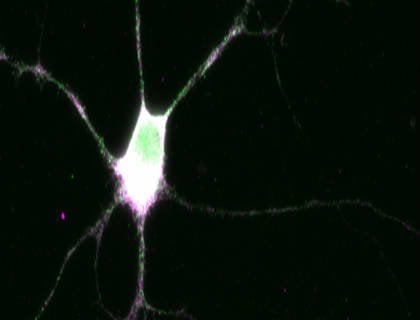Learning requires constant reconfiguration of the connections between nerve cells. Two new studies now yield new insights into the molecular mechanisms that underlie the learning process.
Learning and memory are made possible by the incessant reorganization of nerve connections in the brain. Both processes are based on targeted modifications of the functional interfaces between nerve cells – the so-called synapses – which alter their form, molecular composition and functional properties. In effect, connections between cells that are frequently co-activated together are progressively altered so that they respond to subsequent signals more rapidly and more strongly. This way, information can be encoded in patterns of synaptic activity and promptly recalled when needed. The converse is also true: learned behaviors can be lost by disuse, because inactive synapses are themselves less likely to transmit an incoming impulse, leading to the decay of such connections.
How exactly an individual synapse is altered without simultaneously affecting nearby nerve cells or other synapses on the same cell is a question that is central to Michael Kiebler’s research. Kiebler, a biochemist, holds the Chair of Cell Biology in the Faculty of Medicine at LMU. “It is now clear that the changes take place in the cell that is stimulated by synaptic input – the post-synaptic cell – and in particular in its so-called dendritic spines,” he says, “and particles that are known as “neuronal RNA granules” deliver mRNA molecules to these sites“. These mRNAs represent the blueprints for the synthesis of the proteins responsible for reconfiguring the synapses. Kiebler‘s team has developed a model, which postulates that these granules migrate from dendrite to dendrite, and release their mRNAs specifically at sites that are repeatedly activated. This would ensure that the relevant proteins are synthesized only where they are needed within the cell.

In spite of the potential significance of the model, the molecular mechanisms required for its realization have remained obscure. mRNA-binding proteins, including Staufen2 (Stau2) and Barentsz, are essential components of the granules, and Kiebler’s team, in collaboration with Giulio Superti-Furga’s group (CeMM, Vienna), have now used specific antibodies to isolate and characterize neuronal granules that contain either Stau2 or Barentsz.
Surprising diversity
It has generally been assumed that all neuronal RNA granules have essentially similar compositions. However, the new findings indicate that this is not the case. A comparison between Stau2- and Barentsz-containing granules reveals that they differ in about two-thirds of their proteins. “This suggests that the RNA granules are highly heterogeneous and dynamic in their composition,” says Kiebler. “And that makes sense to me, because it would mean that the granules can perform different functions depending on which mRNAs they carry.” Furthermore, the researchers have shown that the granules contain virtually none of the factors known to promote the translation of mRNAs into proteins. On the contrary, they include many molecules that repress protein synthesis. This in turn implies that the process of mRNA transport is uncoupled from the subsequent production of the proteins they encode.
In a complementary study, Kiebler’s team also characterized the mRNA cargoes associated with the granules. “Until now, none of the RNA molecules present in Stau2-containing granules in mammalian nerve cells had been defined, but we have now been able to identify many specific mRNAs,” Kiebler explains. Further experiments revealed that Stau2 stabilizes the mRNAs, allowing them to be used more often for the production of proteins. Moreover, the researchers have shown that specialized structures within these mRNAs, called “Staufen-Recognized Structures” (SRS), are essential for their recognition and stabilization by Stau2. “This allows us to propose a molecular mechanism for RNA recognition for the first time,” says Kiebler.
Taken together, the two new papers provide novel insights into the molecular mechanisms that underlie learning and memory. The scientists now want to dissect out the details in future studies. “In the long term, we are particularly interested in the question of how an activated synapse can alter the state of the granules and induce the production of protein,” Kiebler notes. It is becoming increasingly clear that RNA-binding proteins play essential roles in nerve cells. Disruption of their action can lead to neurodegenerative diseases and neurological dysfunction. Clearly, not only classical conditions such as Alzheimer‘s or Parkinson’s disease, in which RNA-binding proteins are always involved, but also cognitive defects or age-associated impairment of learning ability must be viewed in this context,” Kiebler concludes.
Notes about this neuroscience and learning research
Contact: Luise Dirscherl – Ludwig-Maximilians-Universität München
Source: Ludwig-Maximilians-Universität München press release
Image Source: The image adapted from the Ludwig-Maximilians-Universität München press release.
Original Research: Full open access research for “Interactome of Two Diverse RNA Granules Links mRNA Localization to Translational Repression in Neurons” by Renate Fritzsche, Daniela Karra, Keiryn L. Bennett, Foong yee Ang, Jacki E. Heraud-Farlow, Marco Tolino, Michael Doyle, Karl E. Bauer, Sabine Thomas, Melanie Planyavsky, Eric Arn, Anetta Bakosova, Kerstin Jungwirth, Alexandra Hörmann, Zsofia Palfi, Julia Sandholzer, Martina Schwarz, Paolo Macchi, Jacques Colinge, Giulio Superti-Furga, and Michael A. Kiebler in Cell Reports. Published online December 19 2013 doi:10.1016/j.celrep.2013.11.023
Full open access research for “Staufen2 Regulates Neuronal Target RNAs” by Jacki E. Heraud-Farlow, Tejaswini Sharangdhar, Xiao Li, Philipp Pfeifer, Stefanie Tauber, Denise Orozco, Alexandra Hörmann, Sabine Thomas, Anetta Bakosova, Ashley R. Farlow, Dieter Edbauer, Howard D. Lipshitz, Quaid D. Morris, Martin Bilban, Michael Doyle, and Michael A. Kiebler in Cell Reports. Published online December 19 2013 doi:10.1016/j.celrep.2013.11.039
#neuroscience, #learning, #memory, #openaccess, #openscience







